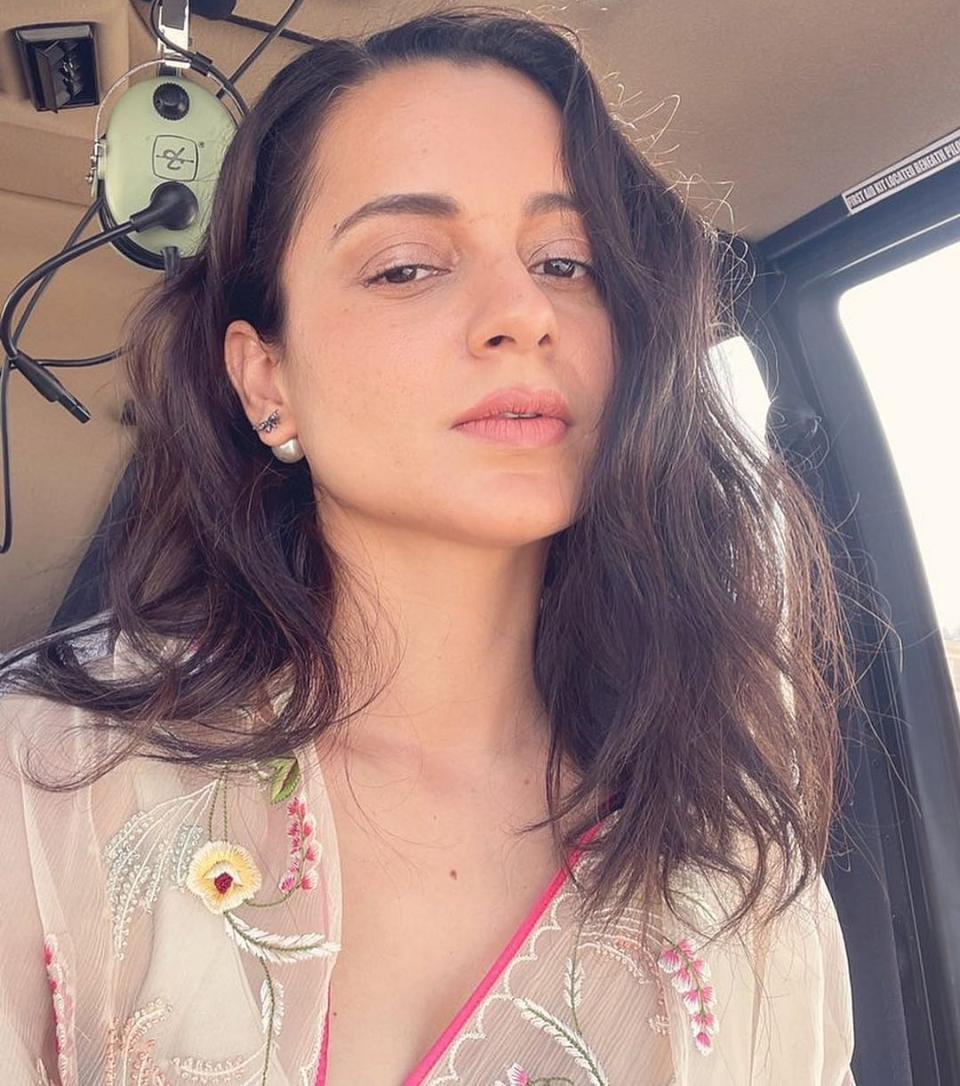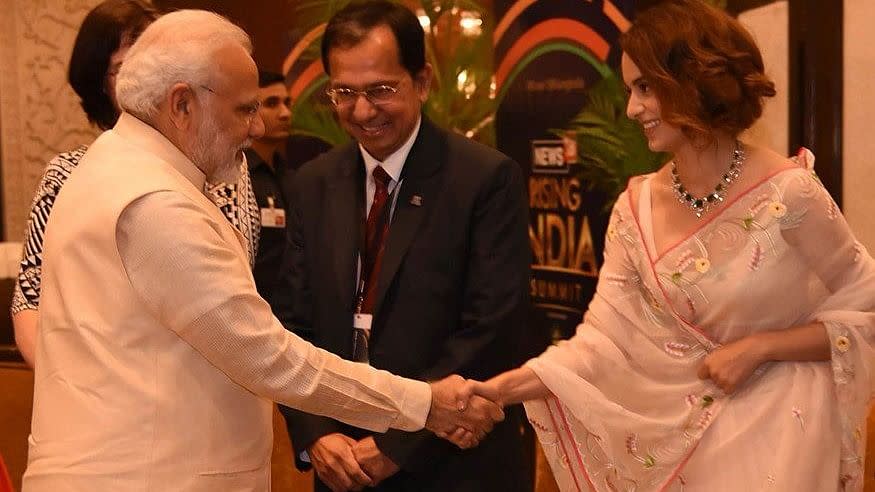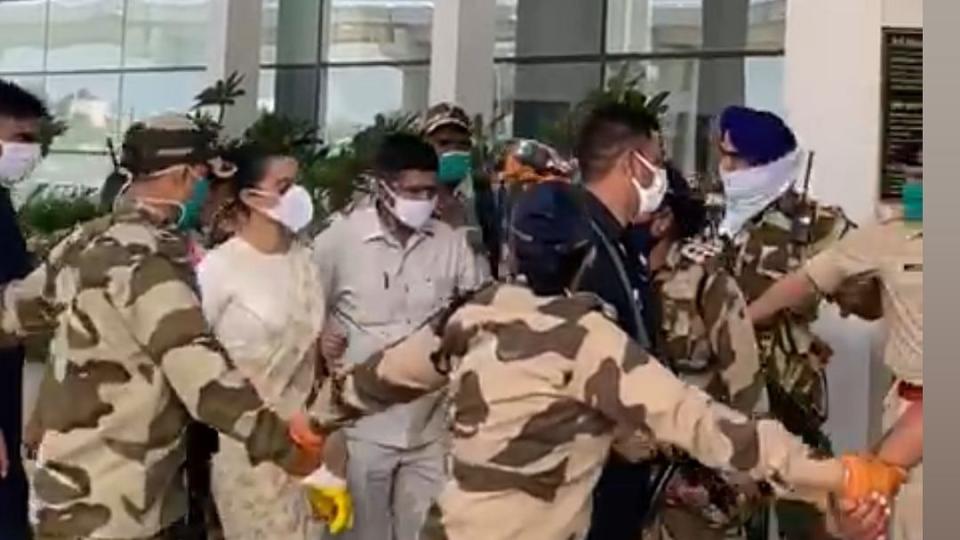Kangana Ranaut: Delusional Fangirl or Aspiring Genocidal Dictator?

A little under a fortnight ago, Kangana Ranaut threw an open challenge at Prime Minister Narendra Modi to tame his opponent in West Bengal using his leadership style of the early 2000s. Apparently, this was enough for Twitter to permanently suspend the account of the Bollywood actress.

You’d have to be painfully unaware to not know that she was alluding to the 2002 Gujarat riots in her tweet. But given its careful wording, she could be talking about anything from his tea-making skills to fighting crocodiles. I mean, who knows how all of this works anymore, right?
And given that her documented history of hate speech on Twitter has some way worse contenders, it was surprising that this was the one that broke the proverbial camel’s back.
Also Read: All the Times Kangana Ranaut Celebrated the ‘Death of Democracy’
Twitter’s official stand was that she repeatedly violated their rules on hate speech and abusive behaviour, and so they decided to cut the cord. But you wouldn’t really be reaching if you thought there’s more to this. It’s highly possible that someone important made a phone call and said, “She’s becoming an embarrassment. It’s time to dump her.”
Kangana hasn’t always been the right-wing-hate-spewing-genocidal-Islamophobe that we’ve been seeing on social media for the past year or so.
It’s just the latest in a series of avatars she’s carefully crafted over the years. And going by past record, her avatar creation is very immersive. There’s no debating the talent that’s there — the same talent that’s won her multiple National awards has been put to good use in the real world. The problem with a fake persona, however, is the need to keep the mask on at all times. You drop your guard once, and your cover’s blown.
Kangana’s earliest avatar was the one that was probably the most believable because it was so close to her lived reality. The small-town girl from Manali who unabashedly said things as she saw them, without a put-on accent, wearing her honesty on her sleeve. She was the girl who made it despite the odds and the nepotism in the industry. You couldn’t help championing her as she took on the industry bigwigs.
Kangana was the ‘face of tomorrow,’ a harbinger of better days ahead for outsiders wanting to make it in the highly competitive entertainment industry. Teenagers across small-town India began looking up to her as a positive role model.
As her star rose, there came an additional layer of sophistication that would be seen as a natural progression for one whose entire persona was based on being a spokesperson of the underdog. She slowly and surely took on the mantle of being ‘the’ feminist in the industry, the most vocal one at the very least. Over the next few years, Kangana became every liberal’s wet dream. She was self-made, she was a feminist icon and she stood for the little guy.

Kangana slowly and surely took on the mantle of being ‘the’ feminist in the industry.
Then the mask began to drop, little by little.
It all started about two years back, when Kangana surprised a lot of her fans by professing her admiration for Prime Minister Modi. She waxed eloquent about his success story, from tea-seller to prime mister, and called him a role model. Had this been any other person at any other juncture in our country’s history, no one would have even blinked. Kangana however, had so far not shown any interest in politics or political figures, and for her to pick someone who’s seen as a highly divisive figure by half of this country’s population, was a big deal in itself. It raised the hackles of a huge chunk of her liberal fans, who began calling out her hypocrisy. After all, one can’t profess to stand for the underdog and in the same breath express admiration for someone whose critics believe has built an entire career on the pillars of communal violence. Or could she?

Kangana Ranaut with Prime Minister Narendra Modi in Delhi.
Some of her die-hard fans would argue that it was just admiration for the man and not his politics. Maybe it was the fact that they were both small-towners who made it big. Maybe it was the fact that they both proudly spoke with their regional accents and didn’t care about those shaming their English-speaking skills. Maybe it was the fact that both of them were seen as outsiders and disruptors in their respective fields, with their unabashed rhetoric. Maybe it was the fact that they both saw themselves as warriors. A fan could selectively pick these reasons for Kangana’s new-found love for the prime minister but the similarities unfortunately, didn’t end there.
There was suddenly a newfound jingoism with Kangana.
From being a proud Himachali, her new identity had now changed to being a proud Hindu from Manali.
She built a new temple in her hometown and proudly wore her religion on her sleeve. The message was clear — she was still a warrior for the underdog and the small towner, but preference would be given to Hindus. Kangana’s social marketing team also began working fervently on a new image of her as a ‘true patriot.’ And how does one know true patriots in this industry? They call for Pakistan to be destroyed. They then call out other actors as anti-national for accepting awards at cultural events in Pakistan. They also make nationalistic period films, with their own twisted versions of history.
In her sister Rangoli, Kangana found the perfect ally. Rangoli manned the helm on social media platforms, showering love and admiration for our prime minister, and spewing hate for anyone who questioned the government or was remotely liberal.
Oh, and for muslims in general. The voice was officially Rangoli’s but everyone knew it was Kangana’s. She had created the perfect foil between herself and the masses, taking the blame for nothing but coming out in defence of her sister’s genocidal tweets like a protective younger sister. If she still had any liberal fans left at this point, she probably pissed them all off with a comment about liberals being fanatics who were bastardizing national sentiment.
Those saying she was still a feminist were being reminded daily that this was someone who was caught on camera laughing at rape jokes.
From being someone who called out the deep-rooted sexism in the industry, she had become that person whose idea of being a real Indian woman was the ability to wear a sari. Kangana had clearly decided to trade her existing fan base for a new one and the results were amazing.
Never had she ever had a following this rabid, willing to pounce on any detractor with the kind of fervour that only comes with blind faith. And she was a refreshing change from the Vivek Agnihotri and Ashoke Pandit variety of B-list influencers that the right wing had so far been able to muster.
When she took on the Maharashtra government, she became their pride, so much so that she was given a Y+ security detail when she re-entered Mumbai. For the uninitiated, that translates to a total of 11 personnel, including a couple of commandos and two personal security officers (PSOs). Her security detail then walked in a cordon around her as she ‘bravely’ walked down the aisles of an empty airport looking stunning in a sari and shades. It could have all been straight out of a Guru Randhawa music video. Except this was real life mimicking some dystopian joke. And this, unfortunately for Kangana, was as good as it was going to get.

Kangana was offered Y+ security when she took on the Maharashtra government.
The actor ‘officially’ joined Twitter under 10 months ago and that’s when things really began going downhill for her. She was now officially responsible for every word being posted in her name. She was quick to jump on to the #JusticeForSSR bandwagon, and like many of our television news anchors, began dropping unsubstantiated conspiracy theories with nary a shred of evidence. She went on to accuse ‘Bollywood’s drug lords’ for the actor’s death, and claimed that Sushant was killed because he knew ‘dirty secrets.’ That the NCB (Narcotics Control Bureau) didn’t take up her generous offer of helping with the investigation says more about her than it does about them.
Kangana was quickly adding to her reputation as a motor mouth. People were now talking about her opportunism knowing no bounds, be it using a fellow actor’s death to promote herself or propagating fake news about those who she saw as adversaries.
Ironically, it’s not the hate filled posts that began driving regular people away — it was the lack of empathy in the middle of this pandemic. Some of her own fans spoke of her tweets sounding biased and insensitive to the sufferings of others. She still had the RW troll army on her side though, and the hate-filled-tirades continued and were encouraged, on Twitter and Instagram.
Kangana might have been living with the delusion that she had attained demigod status and was operating independently but there’s no such thing as a free lunch. The fact that she had a free rein to spout all her nonsense and spread fake news, was only because she was furthering an agenda that was part of a larger state-driven machinery. And sometimes, it’s easy to get caught up in the role-play, so much so that one forgets there are boundaries and rules when you’ve chosen to become part of that machinery.
Rule No. 1 is you don’t question the hand that feeds you.
Rule No. 2 is you don’t embarrass them.
Kangana broke that second rule when she brought up something that PM Modi has spent a good part of the last decade trying to whitewash. While hordes of users on Twitter have been reporting Kangana’s toxic tweets for months, this one would have been an embarrassment for many on her own side too. It’s not surprising then, that she copped a permanent ban on Twitter. What will be interesting to see is how the next few months play out on Instagram, the platform she’s focusing all her energies on after being thrown off Twitter. While she’s had the Instagram account since 2016, it’s only of late that she has started posting her own thoughts and videos.
A few days back, Kangana drew the ire of multitudes of Instagram users with her inflammatory posts on Palestine. But she’s called for genocide before and gotten away with it. So, nothing new there. What is interesting though is that she’s gone back to questioning the government’s inaction in West Bengal, this time with a few personal barbs and digs at the Prime Minister. Sample this: “If you are suddenly taken over by a desire to win Nobel peace prize please know that it will be smeared in Hindus blood…” (sic).

How soon before she breaks Rule No. 1 in a way that won’t go down well with the powers-that-be? Given her history of toxic relationships, is the regime’s love for Kangana on the wane? Maybe this is all just part of a plan, a step towards her next avatar. Maybe she sees herself as the new poster child of hard right-wing politics, one that will replace what she clearly considers a softer brand of the same. With Kangana, do we really know anything?
(This is an opinion piece, and the views expressed are the author’s own. The Quint neither endorses nor is responsible for them.)
Also Read: Kangana Posts Another Insensitive Note After Testing Negative
. Read more on Celebrities by The Quint.Review: ‘Sardar Ka Grandson’ Is a Boring Film That Falls Flat Kangana Ranaut: Delusional Fangirl or Aspiring Genocidal Dictator? . Read more on Celebrities by The Quint.

 Yahoo Movies
Yahoo Movies 
